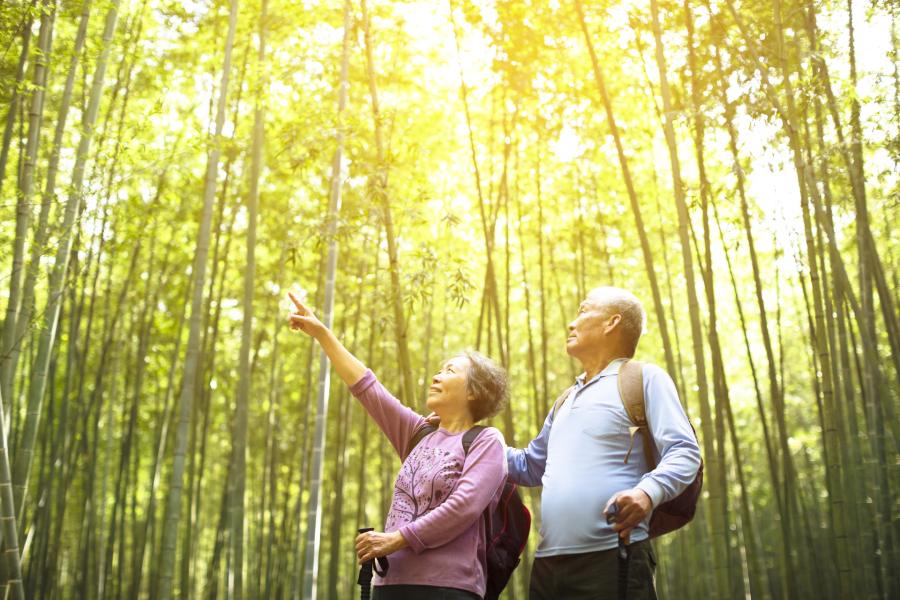What age group travels the most?
For the past fifteen or so years, Millennials (1981-1996) were most likely to go into debt for travel with an average of 35 vacation days per year. But the Baby Boomers (1946-1964) travel an average of 4-5 times per year and are more likely to afford it comfortably.
And now that the world is slowly opening up again, we’re seeing some surprising senior tourism statistics.
According to a recent survey by Silver Travel Advisor, 77% of senior travelers plan to book and travel within 6 months of getting vaccinated and 46% of respondents said they will make the most of it by traveling as much as possible. Even going as far as saying that they’ve missed overseas travel more than hugging their grandchildren.
And Skift says numerous tour operators have seen an increase in bookings from older travelers already, such as Quasar Expeditions who are receiving inquiries for June onward with 70% of guests being over 65 or Wild Terrains who have seen a 40% jump in bookings, largely from women older than 55.
So, if your ideal guest is on the younger side, perhaps you might want to try targeting the often overlooked, yet incredibly valuable senior market segment for the opportunity to boost your bookings and stand out from the competition.
The importance of senior tourists
Beyond the pandemic, the senior tourism segment (ages 50+) has a huge impact on the travel industry. In 1999, over 593 million international travelers were 60 years and older, which accounted for around 1/3 of holiday spending. And this number is projected to reach 2 billion trips annually by 2050 — according to the World Tourism Organization.
That’s because it’s estimated seniors will comprise nearly a quarter of the world’s population by 2050, compared to only 10% in 2000. Meaning that they will be responsible for more holiday spending in the future than all of the younger age groups combined.

This is already proving to be true in the United Kingdom where people over 50 drive close to 60% of travel and tourism spend — spending $3 billion more than their Millennial counterparts. And it makes sense. Older travelers have a higher average disposable income and if retired, the free time to go on extended trips (8 weeks or longer).
So as the ageing population grows and becomes the most important tourist group due to their purchasing power and trip frequency, there will be a call for senior-friendly tourism products. Luckily for tour and activity operators, Baby Boomers love leisure travel, often seeking enriching and meaningful experiences, particularly sightseeing.
Why older people like to travel
There are many reasons why seniors choose to spend more of their income on travel and less on other things. Just like most other travelers, they too enjoy the rest and relaxation, sense of adventure, meeting new people, and seeing bucket list places.
So, this tourism segment isn’t exactly homogeneous. Not in any way, shape, or form. Often, when we think of senior travelers, we picture cruise ship passengers, retiring at sea while traveling the world. But if you want to be successful in targeting them as part of your tour and travel marketing strategy, you must avoid resorting to stereotypes and instead find a niche within this demographic that makes sense for your business.
Because once you have a more accurate understanding of their travel motive — not a generalized assumption — you can better align your tours and marketing messaging.
While there is a broad spectrum of senior travelers, we can essentially break down this travel segment into two categories:
1. Young at heart
Senior travelers who are young-at-heart don’t let their age hold them back. Packing along great physical health and a zest for life, they shatter traditional assumptions by seeking out challenging experiences to push their limits and prove they’ve still got it.
Valuing a sense of accomplishment and embracing life to the fullest, they are the ones who want to explore the ends of the Earth, immerse themselves into different cultures, and face their fears by doing things they never thought they could do before.

So, you might see them staying at guest houses and mingling with younger travelers, visiting remote and off-the-beaten-path destinations, or participating in adrenalin-filled and adventurous activities, like rafting, canyoning, scuba diving, and skiing.
2. Old at heart
On the other hand, senior travelers who are old-at-heart travel for the benefits it provides to their physical, mental, and social well-being. As a change up to their daily routine, they enjoy tourist activities that involve moving at a leisurely pace, learning new skills, expanding their knowledge, indulging in the finer things, and interacting with people.
That’s why they tend to lean towards staying in luxury hotels or cozy BnBs, taking history tours, cooking classes, or dance lessons, and booking travel packages that guarantee the chance to socialize with other senior travelers while having transport, food, and other trip arrangements taken care of for them.

And since they might have some type of disability — almost 38% of people over 65 do — they are usually more concerned about security and danger, travel plans falling through, and hurting themselves or getting sick in an unfamiliar destination.
So, this type of senior traveler often takes a more nostalgic approach to travel, visiting destinations they already know and love from a childhood vacation, honeymoon, or ancestry ties. Or, you’ll see them travelling with companions, such as friends, family, or senior clubs, ensuring that if anything were to happen, they’d have support.
Senior-friendly tourism products
According to this study, the most popular tourist activities amongst the senior age group are city sightseeing (89.3%), visiting historical places (88.1%), restaurant dining (85.7%) and shopping (77.4%). Less popular tourist activities include hunting and fishing (1.2%), water sports and sunbathing (1.2%) and camping and hiking (3.5%).
But these senior tourism statistics don’t tell the whole picture. As I pointed out, not every senior traveler is the same. On one side, you might have someone who prefers adventure travel and on the other, someone who wants a more upscale experience.
For example, a young-at-heart senior traveler might be more inclined to book a ranger-led nature walk in Yellowstone or a horseback riding tour along the beaches of Costa Rica. Whereas a senior in the old-at-heart group might opt for low physical activities, like wine tasting in Italy, taking a pottery class in Sante Fe, or going on a bus tour in Scotland.

In other words, no tourism product’s a one-size-fits-all for senior travelers. Sure, there might be commonalities they look for — such as all-inclusive packages, hassle-free transport, quality over utility, and well-balanced food options. But for the most part, what appeals to them individually will vary across niches within this demographic.
So, whether you offer budget vs luxury experiences, guided vs self-guided tours, or adventurous vs cultural activities, you already have the best tourism product for the right senior traveler. You just have to know how to reach them and speak their language.
That is unless you offer something totally extreme, like heli-skiing.
Senior tourism trends for marketing
Most senior travelers don’t like to think of themselves as senior travelers — unlike solo travelers who can’t stop talking about being solo travelers. That’s why they don’t respond well to ageist marketing. I’m referring to stock images showing their limited abilities or use of outdated technology.
Instead, they need to see imagery of mature adults living their full lives. And who’s better than a tour or activity operator to promote that? You can share photos of seniors kayaking, hiking, dancing, socializing, learning, cooking, doing all the things they imagined doing more of as empty-nesters and retirees.

But the real magic lies in your copy. Just as you’d point out specific benefits in your tour descriptions for your ideal guest, you can focus on a niche within the senior demographic and highlight the things they care about most in the experience, like:
- A leisurely pace
- Small group sizes or kid-free
- Chance to meet new people
- Range of activity levels
- Included travel arrangements
- A rewarding challenge
- Authentic cultural experience
- Accessibility
- Wildlife photo opportunities
- Learning new skills
- Deep dive into history
- Grandkid-friendly
- Flexible food choices
- Walking in ancestor’s footsteps
- Bucket list experience
TourRadar does this flawlessly in their senior messaging. Look at how they target both the young-at-heart and old-at-heart in the below tour description.

At the same time, you’ll want to make sure to answer any questions they may have on your FAQ page. Since senior tourism is linked to accessible tourism, this will also help you be a more inclusive operator. Here are a few examples:
- Do I need to be physically fit to go on the tour?
- I am a solo traveler, will I need to pay a single supplement?
- I am over 75 years old, can I still join the tour?
- Are there bathrooms?
- Am I able to travel with a wheelchair?
- Can I take my medication with me?
- Can I reserve a specific seat on the coach bus?
- I have a sleep apnea machine, can I bring this with me?
Okay, but how do you reach the senior traveler once you have all of that in place? What marketing channels will you find the most success?
While Millenials are most influenced by online travel marketing, Baby Boomers come second as the group most influenced by travel ads, especially on Facebook, which is the most popular social media platform for seniors. For instance, History Well Traveled discovered that the older generation engages most with their Facebook ads.
But seniors still spend less time on the internet than their younger counterparts. And many of them still prefer booking their trips through travel agencies. So, you might also want to consider expanding your travel partner network, including reaching out to hotels, DMOs, or other local businesses and promoting your tourism products through offline channels as well, such as newspapers, radio, or brochures.
Final thoughts
The senior tourism market is often overlooked by tour and activity operators. But as the ageing population grows, they’ll be the top travel spenders in the future, and frankly, they already are. So, if you want to make the most of the upcoming travel boom and beyond, this might be one audience you should pay attention to.
Are you ready for senior tourists to come back?

Take your business to the next level
Online bookings. Flexible pricing. Outstanding support.



